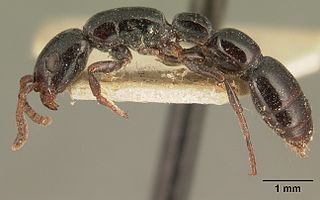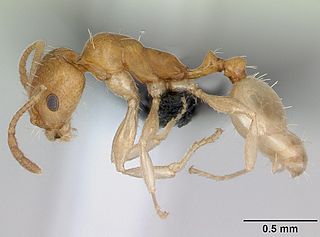
The common flat-tail gecko is a gecko endemic to Madagascar. It is found in eastern Madagascar and on the islands Nosy Bohara and Nosy Mangabe. These geckos live in tropical rain forests. They reach a total length of 330 mm.

Helodranon' Antongila, more commonly called Antongil Bay in English, is the largest bay in Madagascar. It is at the northern end of the east coast of the island and for administrative purposes it is within Analanjirofo Region. The bay is about 60 kilometres (37 mi) long and 30 kilometres (19 mi) wide, and is formed by the Masoala peninsula on its eastern side. At the northern end of the bay is the island of Nosy Mangabe and the town of Maroantsetra.

Dolichoderinae is a subfamily of ants, which includes species such as the Argentine ant, the erratic ant, the odorous house ant, and the cone ant. The subfamily presents a great diversity of species throughout the world, distributed in different biogeographic regions, from the Palearctic, Nearctic, Afrotropical region and Malaysia, to the Middle East, Australian, and Neotropical regions.
Maroantsetra is a market town and domestic seaport in Analanjirofo Region, Madagascar, at the northern end of the Bay of Antongil.

Masoala National Park, in northeast Madagascar, is the largest of the island's protected areas. Most of the park is situated in Sava Region and a part in Analanjirofo. Created in 1997, the park protects 2,300 square kilometres of rainforest and 100 square kilometres of marine parks. The Masoala peninsula is exceptionally diverse due to its huge size, and variety of habitats. Altogether, the park protects tropical rainforest, coastal forest, flooded forest, marsh, and mangrove. Three marine parks protect coral reefs and a dazzling array of marine life.

Nosy Mangabe is a small island reserve located in Antongil Bay about 2 km offshore from the town of Maroantsetra in north-east Madagascar. it is accessible by small boat and is part of the larger Masoala National Park complex. It is a tropical rainforest preserve and sanctuary for a species of lemur, the aye-aye. It lies close enough to Maroantsetra for a day trip, although an overnight stay is recommended for seeing the nocturnal aye-aye.

Gallieniellidae is a family of spiders first described by J. Millot in 1947. It was originally thought to be endemic to Madagascar until species were also found in southern Kenya, northeastern Argentina, and Australia. Drassodella was transferred from the family Gnaphosidae in 1990. They are suspected to be specialized in ant-preying.

Analanjirofo is a region in northeastern Madagascar. Until 2009 it was a part of Toamasina Province. It borders Sava Region to the north, Sofia Region to the west, Alaotra-Mangoro Region to the southwest and Atsinanana Region to the south.

Aptinoma antongil is a species of ant in the subfamily Dolichoderinae. The species is known only from Antongil Bay, Madagascar.

Eutetramorium is a small genus of ants within the subfamily Myrmicinae. To date it contains three species found in Madagascar and Comoros.
Tanipone is a Malagasy genus of ants in the subfamily Dorylinae.

Simopone is a genus of predominantly arboreal ants in the subfamily Dorylinae. The genus is widely distributed in the Old World tropics, with the majority of species in Madagascar and sub-Saharan Africa.

Aptinoma is a small genus of arboreal ants in the subfamily Dolichoderinae. Its two species are known only from Antongil Bay, Madagascar.

Ravavy is a Malagasy genus of ant in the subfamily Dolichoderinae containing the single species Ravavy miafina.

Myrmisaraka is a Malagasy genus of ants in the subfamily Myrmicinae. Described in 2014, the genus contains two species.
Malagidris is a Malagasy genus of ants in the subfamily Myrmicinae. Described in 2014, the genus contains six species.

Vitsika is a Malagasy genus of ants in the subfamily Myrmicinae. Described in 2014, the genus contains 14 species.

Royidris is a Malagasy genus of ants in the subfamily Myrmicinae. Described in 2014, the genus contains 15 species endemic to Madagascar.
Suffascar is a genus of Malagasy ant spiders first described by A. Henrard & Rudy Jocqué in 2017.















